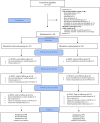EMMATKA trial: the effects of mobilization with movement following total knee arthroplasty in women: a single-blind randomized controlled trial
- PMID: 39979944
- PMCID: PMC11841275
- DOI: 10.1186/s13018-025-05568-8
EMMATKA trial: the effects of mobilization with movement following total knee arthroplasty in women: a single-blind randomized controlled trial
Abstract
Background: Mobilization with Movement (MWM) is an examination and management approach for correcting the intra-articular translational and rotational movements to facilitate the active physiological movement. The study aimed to determine the effects of MWM on Total Knee Arthroplasty (TKA) using a randomized controlled trial (RCT) design.
Methods: The trial is registered (ISRCTN ref: 13,028,992). A blinded examiner assessed patients at pre-surgical (before TKA), post-surgical (at 3-weeks post-TKA), 6-weeks and 6-months post-TKA. Participants were randomly assigned to receive MWM (six sessions, between 3 and 6 weeks post-TKA) plus standard rehabilitation (intervention group) or standard rehabilitation alone (control group) of outpatient rehabilitation including range of motion and strengthening exercises, cycling, gait and stair training. Outcome measures were range of motion (goniometer), pain (visual analogue scales), physical function (Timed Up and Go (TUG)), a 15-m walk test, and health status (Western Ontario and McMaster (WOMAC) Osteoarthritis Index). Change in outcome measures from post-surgical to 6 weeks and 6 months post-TKA were compared between groups. The primary outcome was change in knee flexion range of motion at 6 weeks.
Results: 84 women scheduled for TKA were randomly allocated to intervention (n = 42) or control (n = 42); mean ± (SD) age 65.1 ± 7.4 and 66.8 ± 8.9 years, respectively. The intervention group demonstrated significantly greater increase in knee flexion at both 6 weeks (median (IQR) + 10.000 (20.000) compared with + 2.500 (6.250) in the control group) and 6 months (+ 12.500 (15.000) and + 5.000 (10.000) respectively) (both p < 0.05). There were no differences between groups in secondary outcomes.
Conclusion: Introducing MWM for TKA rehabilitation has greater benefits for women post-TKA in increasing knee joint flexion range of motion than the standard rehabilitation programs in the short and medium-term. This evidence-based approach offers a promising adjunctive intervention for optimizing recovery and rehabilitation process following TKA in women. Clinicians should consider including MWM approach in post-TKA rehabilitation programs.
Level of evidence: I.
Keywords: Knee arthroplasty; Manual therapy; Mulligan approach; Range of motion; Rehabilitation; Surgery.
© 2025. The Author(s).
Conflict of interest statement
Declarations. Ethics approval and consent to participate: This study was approved by the Kuwait Ministry of Health Research Committee (ref:767/2018). Written informed consent was obtained from participants. Consent for publication: Not applicable. Competing interests: The authors declare no competing interests.
Figures



References
-
- Cross M, Smith E, Hoy D, Nolte S, Ackerman I, Fransen M, Bridgett L, Williams S, Guillemin F, Hill CL, Laslett LL, Jones G, Cicuttini F, Osborne R, Vos T, Buchbinder R, Woolf A, March L. The global burden of hip and knee osteoarthritis: estimates from the global burden of disease 2010 study. Ann Rheum Dis. 2014;73(7):1323–30. - PubMed
-
- Giwnewer U, Rubin G, Orbach H, Rozen N. Treatment for osteoarthritis of the knee. Harefuah. 2016;155(7):403–6. - PubMed
-
- Hussain SM, Neilly DW, Baliga S, Patil S, Meek R. Knee osteoarthritis: a review of management options. Scott Med J. 2016;61(1):7–16. - PubMed
-
- Quinn RH, Murray JN, Pezold R, Sevarino KS. Surgical management of osteoarthritis of the knee. J Am Acad Orthop Surg. 2018;26(9):e19–193. - PubMed
Publication types
MeSH terms
Grants and funding
LinkOut - more resources
Full Text Sources
Medical
Research Materials

